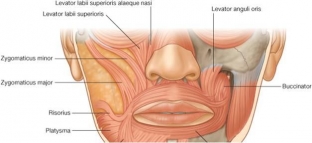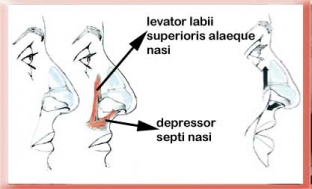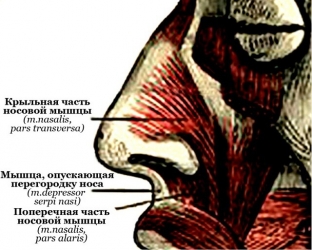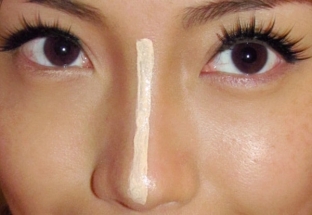The nose plays an important role in the aesthetics of the face of both men and women. In this regard, it is easy to understand the growing interest in the correction of defects in the shape, size and volume of the nose for several centuries or even since ancient times. In the last decade, all surgical and cosmetic minimally invasive techniques are developing exponentially.
Methods of rejuvenation and correction of imperfections of the nose have been widely developed in medicine of the third millennium. In many cases, non-surgical correction methods are attractive due to their low invasiveness of the procedure. We will describe the method of combined use of botulinum toxin A (BTxA) and absorbable fillers for aesthetic correction of the shape of the nose.
With this integrated approach, BTxA will reduce imperfections associated with muscle hypertonicity, while hyaluronic acid fillers will correct all imperfections in the nose profile from root to tip. Correction of the nose, based on a sound knowledge of anatomy and the use of correct techniques for the introduction of fillers, will avoid most of the side effects. Patients rated this method of correction as effective and long lasting.
Let's pay attention to the subtleties of nose correction with botulinum toxin A (BTxA).

Previously, when correcting this area, we chose the blockade point, which was located at a distance of 1.5 cm from the inner corner of the eye to the middle of the back of the nose. It was at this point that the intradermal injection was made. Thus, with the introduction of 4 U of Dysport (1 division of an insulin syringe when diluting a bottle of 500 U with 1.5 ml of saline), we reduced the motor activity of the nasal muscle (m. nasalis).
At the moment, it is more relevant to use another technique - turning off the nasal muscle without blockade of m. levator labii superioris alaeque nasi, because in practice, it became clear that the blockade almost never works properly.
To improve the effect of , you can turn off m. levator labii superioris alaeque nasi. It is more convenient to do this using the following protocol:
- we insert the needle lateral to the wing of the nose into the deepest part of the nasolabial fold. We touch the nasal bone with the needle and, slightly retreating, inject the drug in 1-2 divisions of the insulin syringe.
From side effects, we can expect increased diffusion of the drug, which leads to a decrease in the mobility of the upper lip, and the lip may sink onto the teeth. To avoid such complications, it is recommended to use a 1.5 ml dilution of Dysport rather than 2.5 ml.
You can block this muscle higher, but you must remember that the angular artery runs along the bony back of the nose. Muscle m. levator labii superioris alaeque nasi runs almost along the seam between the nasal bone and the upper jaw. Therefore, if we want to block without complications, we need to find a point above the wing of the nose in the place where the nasal bone just begins, at the moment of transition to the upper jaw. It is in this hollow that m goes. levator labii superioris alaeque nasi, and better block right here.
How to narrow anatomically wide nostrils

In old anatomy textbooks, the muscle responsible for dilating the nostrils was considered an offshoot of m. levator labii superioris alaeque nasi & nbsp; and passed to the wing of the nose. It was considered as one continuous nasal dilator with the function of dilating the nostrils. Now it is considered as a separate transverse muscle that expands the wings of the nose.
To reduce the activity of the muscle that is responsible for the expansion of the wings of the nose, it is enough to inject 0.5 divisions of the insulin syringe at a dilution of 1.5 ml directly into the hole above the ala of the nose. Remember that administration at this point can be either intradermal or subdermal. In this place, we are not threatened by either the diffusion of the drug or the misalignment of the nose.
Should the septal depressor muscle be switched off? Nobody does this in clinical practice. Hyperactivity of this muscle is quite rare. And given that now fillers produce a very wide modeling of the nose, as an alternative to rhinoplasty it is safer.

Subtleties of nose correction with hyaluronic acid fillers
Raising the tip of the nose with a filler is not very difficult if you understand correctly where, to what depth and how much correction should be done. To obtain the maximum result, it is necessary to introduce the filler at the border of the dermal and subdermal layers along the septum itself.
It is also mandatory to create a base bolus under the cartilaginous pedicles that make up the septum itself. In order to consolidate the result, it is necessary to make the transition from the forehead to the back of the nose softer and in this place to deliver one bolus of the drug in an amount of 0.3 to 0.5 ml.
A good aesthetic result is obtained by introducing a small amount of the drug through the cannula subdermally along the back of the nose using a linear technique. Such a correction technique will give not only the effect of raising the tip of the nose and narrowing the nostrils in front, but also an aesthetic improvement in the patient's profile.
 The advent of minimally invasive methods, especially aesthetic correction methods, allows highly qualified doctors to correct many minor imperfections, which in many cases required surgical correction. At the moment, it is possible to obtain a significant improvement in appearance that satisfies patients and does not require surgical intervention.
The advent of minimally invasive methods, especially aesthetic correction methods, allows highly qualified doctors to correct many minor imperfections, which in many cases required surgical correction. At the moment, it is possible to obtain a significant improvement in appearance that satisfies patients and does not require surgical intervention.
Author: Elena Stoyanova, Ph.D., Project Manager estet-portal.com







Add a comment